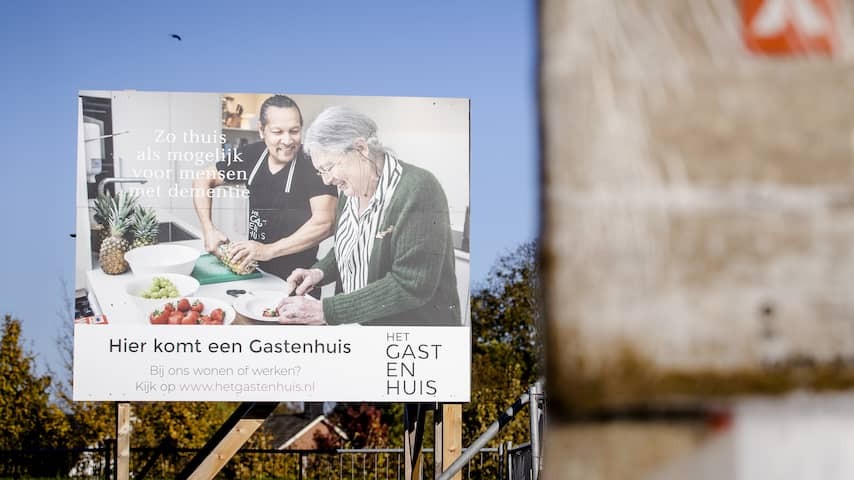
Aging is putting the Netherlands under great pressure, both in healthcare and on the housing market. The Netherlands wants to build 290,000 senior-friendly homes, but experts note that this is difficult. Attention is focused on starters. Understandable, but not wise.
In the coming decades, the number of people aged 85 and over will triple. Not only is the group of elderly people growing, but the average age of the group is also increasing, according to a report by the Netherlands Environmental Assessment Agency (PBL). This ‘double aging’ is causing the demand for care to increase sharply.
“We can alleviate the pressure on healthcare by building more senior-friendly homes,” says Heleen Stigter, secretary of the Stimulus Team Housing Welfare Care for the Elderly. Together with municipalities, investors, care organizations, market parties and housing associations, they are working on solutions.
“Take, for example, the increasing number of people with dementia,” says Stigter. Due to aging, the number of people with dementia is likely to double in the next fifteen years, to 520,000. “If you compare that to the current 130,000 nursing home places, and that number is not going to increase, then it is clear that there will be no place for many people. And I’m not even talking about people with other mental or physical problems.”
Stigter refers to a study by the Scientific Council for Government Policy (WRR) from 2021. It shows that if nothing changes, one in three people will have to work in healthcare in forty years to meet demand. The Netherlands will then have to use almost all of its welfare growth to pay for the rising healthcare costs.
Construction plans fall ‘seriously short’
Caring residential communities offer a solution. “Of course, that’s not the same as professional care,” says Stigter. “But it helps if people look out for each other. Not strict social control, but an eye for each other.” The Stimulus Team wants to stimulate such solutions by building new and adapting the existing housing stock.
For the time being, little is being done to build senior-friendly homes, ABN AMRO noted in mid-2024. The construction plans for that year fell “seriously short” by around 2,800 homes. For 2025, there were plans for 3,000 homes.
Governments, industry organizations and the construction sector agree that something needs to be done. At the housing summit in December, they agreed to build 290,000 senior-friendly homes up to and including 2030. No easy task.
Breaking the impasse on the housing market
In addition to keeping care affordable, building senior-friendly homes has another important advantage. “Moving a senior triggers the most relocations,” says Stigter. “If a senior moves, a house becomes available. A family can move to that vacant house. Someone in an affordable home can move on to the family home and a starter can move to the affordable home.”
That is why suitable senior-friendly homes are “the strategic key to unlocking the housing market,” writes the Dutch Association of Realtors (NVM) in mid-June. The focus on construction is now too much on starters. Understandable, since they have to make more and more effort to have a chance on the housing market.
But building for starters only solves the problems on the surface, according to the NVM. Because there are too few suitable homes for the elderly, they prefer to invest their money in improving their homes. It is not for nothing that renovation is increasingly preferred over moving. As a result, several homes remain occupied. “Building for the elderly breaks this impasse.”
At least 1.1 million people aged 85 and over in 2060
An important misunderstanding is that aging will resolve itself after 2040, when the baby boom generation is gone. That would make building for the elderly financially less interesting. The PBL report also shows that this is a misunderstanding. In 2021 there were 400,000 people aged 85 and over, but in 2060 there will be at least 1.1 million. Maybe even 1.4 million.
“Building senior-friendly homes is therefore also financially interesting in the long term,” says Stigter. Yet she notices that it is going slowly. “New construction is clearly lagging behind. Housing associations are investing more and more, but private parties are cautious. Some developers, for example, are used to consulting with municipalities and housing associations, but find it more difficult to consult with care organizations.”
Step between own home and nursing home is missing
“Given the aging that is coming our way, the situation is unsustainable,” says housing market professor Peter Boelhouwer of TU Delft. “It was a wrong decision to abolish the care homes in 2014 and to focus on lifetime homes. People can live there for a long time, but they become lonely and care is difficult to organize. The step between an own home and a nursing home is missing.”
Boelhouwer is on the advisory board of the Knarrenhof Foundation, which is working on a solution for the housing needs of people over fifty. The concept “provides an answer to the erosion of pensions, aging, the increase in one-person households and the risk of loneliness,” the foundation writes.
Communal spaces are an important part of the solution. But making sure that such spaces are created is not easy, says Boelhouwer. “Communal spaces cost money. Some corporations do invest, but this is particularly difficult in the private sector. There is a financing problem.”
The national government has introduced a subsidy to ensure that suitable senior-friendly homes are created. That subsidy is good, says Boelhouwer, but it needs to be stronger. “The cabinet can do more.”
“The target of 290,000 homes is definitely there, but market parties are not taking it up sufficiently. Ensure available land. Ensure that more money is available for communal spaces. Ensure that investments are attractive to private landlords. The need is really there – aging is the challenge of the future.”